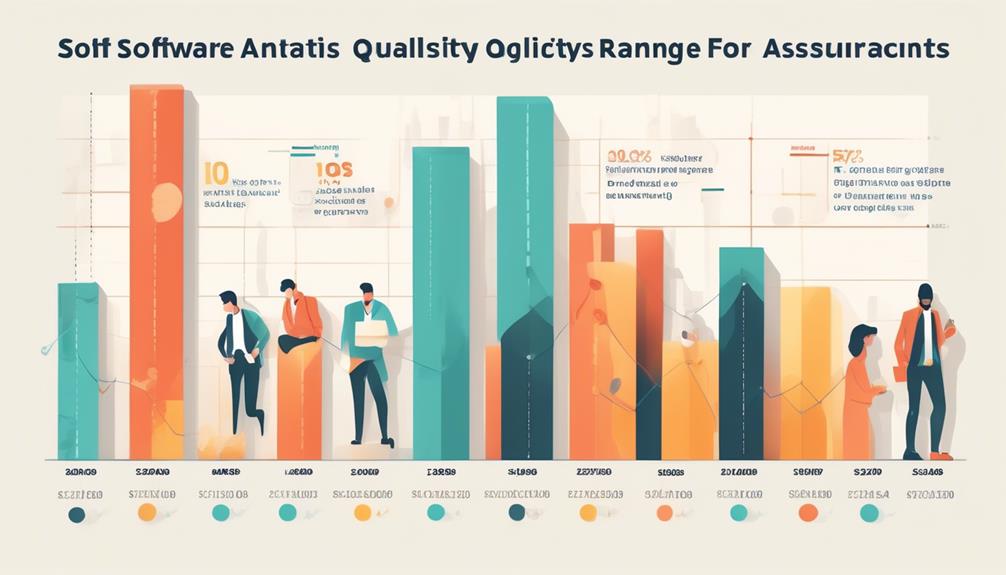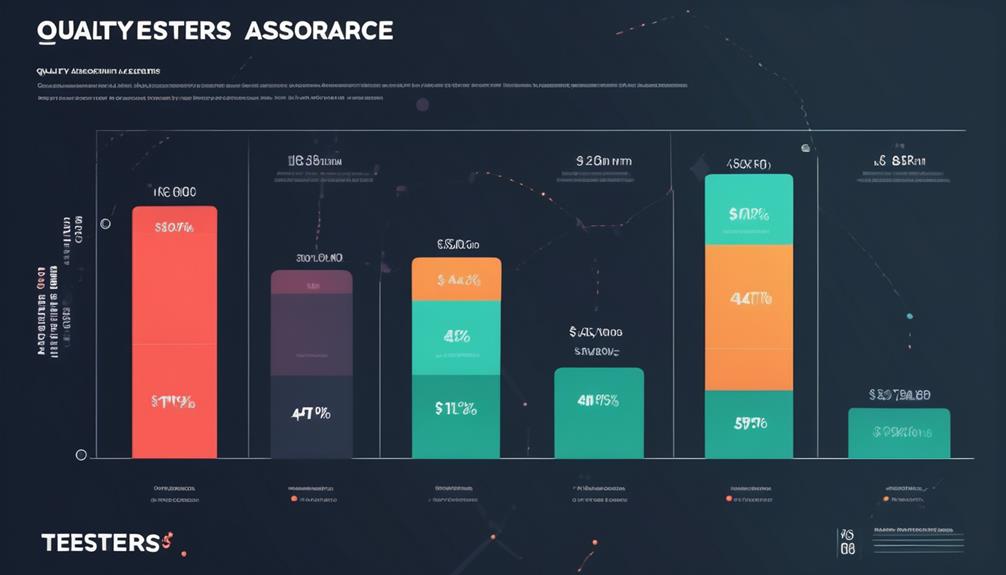SQA Techniques and Tools
Expert Software Testing Services for Quality Assurance

Welcome to Moonshot, where we specialize in providing top-notch software testing services and quality assurance. As a trusted provider of software testing solutions, we recognize the importance of quality in the success of your software applications. Our skilled team of testing professionals is committed to guaranteeing that your software products adhere to the highest standards in functionality, performance, and security.
Software testing is an essential process for evaluating the reliability and effectiveness of your software applications. By conducting rigorous testing, we identify and address any potential defects or issues to ensure a seamless user experience. Our comprehensive approach covers various testing techniques and methodologies to deliver robust software products that align with your business goals.
At Moonshot, we offer a wide range of software testing services to cater to the unique needs of each project. From unit testing to performance testing, our team is equipped with the knowledge and expertise to deliver reliable results. We also utilize cutting-edge testing tools and methodologies to streamline the testing process and maximize efficiency.
Partner with Moonshot for expert software testing services and benefit from our customized testing strategies, thorough QA process, and experienced test engineers. With our commitment to quality assurance, you can enhance the performance and reliability of your software products, gaining a competitive edge in the market.
Key Takeaways:
- Software testing services are crucial for evaluating the functionality, performance, and security of software applications.
- Moonshot offers expert testing services designed to ensure high-quality software products that align with business goals.
- Our team of experienced test engineers utilizes cutting-edge testing tools and methodologies to deliver comprehensive quality assurance.
- We provide customized testing strategies, thorough QA processes, and diligent execution and monitoring of testing activities.
- Partnering with Moonshot for software testing services can enhance the performance and reliability of your software products.
Unit Testing for Robust Software Functionality
Unit testing is an essential software testing technique that focuses on evaluating individual components of the code to ensure they perform as expected. At Moonshot, we understand the importance of unit testing in achieving reliable and robust software functionality.
As the first level of testing in the software testing process, unit testing is often conducted by developers themselves. It involves creating test cases for each individual unit of the code, such as functions or methods, and verifying their correctness and expected output.
Unit tests help validate code correctness by catching bugs and issues early in the development process. They contribute to software design and maintainability by ensuring that each component functions independently and integrates seamlessly with other units.
“Unit testing is like having a safety net for your code. It allows us to catch and fix issues before they propagate to other parts of the software, resulting in more stable and reliable applications.”
By performing unit testing, we can identify and address potential problems early on, saving time and effort in the long run. It allows us to detect and resolve issues related to logic, data flow, and integration at a granular level.
Unit testing provides various benefits, including:
- Improving code quality and reliability
- Facilitating code maintenance and refactoring
- Enhancing software design and modularity
- Enabling faster debugging and issue resolution
Our Approach to Unit Testing
At Moonshot, our experienced team of developers and testers follows industry best practices to ensure thorough and effective unit testing. We design comprehensive test cases that cover various scenarios and edge cases to validate the functionality of each code unit.
Furthermore, we leverage powerful unit testing frameworks and tools to automate the testing process and streamline execution. This allows us to save time and resources while achieving accurate and reliable results.
Our commitment to unit testing reflects our dedication to delivering high-quality software products that meet the expectations of our clients. By conducting rigorous unit testing, we can guarantee robust software functionality and minimize the occurrence of critical defects.
To ensure the success of unit testing and optimize software quality, it is essential to integrate it into a broader software testing strategy. Unit testing is just the first step in the comprehensive testing process that Moonshot provides, ensuring a thorough evaluation of your software.
Next, let’s explore functional testing, another crucial software testing technique that focuses on delivering a seamless user experience.

Functional Testing for Seamless User Experience
Functional testing plays a pivotal role in ensuring the seamless performance of software applications, including web and mobile apps. At Moonshot, we understand the importance of delivering software that functions as intended. Our dedicated Quality Assurance (QA) team meticulously designs and executes test cases, covering a wide range of scenarios to validate every function against specified requirements.
Functional testing involves testing each individual component of an application to determine if it meets the expected functionality. By conducting this thorough evaluation, potential issues can be identified and resolved, ensuring the application’s effectiveness and reliability.
Our experienced testers employ various software testing techniques to verify the application’s behavior under different conditions, ensuring a smooth and intuitive user experience. We analyze how the software responds to user interactions, performing systematic tests that cover inputs, outputs, and system integration to ensure optimal performance.
By conducting functional testing using our software testing solutions, Moonshot helps businesses identify and address functional gaps, usability issues, and any inconsistencies that may arise. Our agile testing methodologies enable us to adapt to changing requirements and deliver high-quality software products.
“Functional testing ensures that software applications perform as intended, delivering a seamless user experience.” – Moonshot
Functional testing is a critical step in the software development process. It helps identify and rectify issues early on, ensuring that the final product meets the desired functional requirements. By leveraging our software testing solutions, businesses can enhance the quality and reliability of their applications, which translates into improved customer satisfaction and brand loyalty.
When it comes to functional testing, Moonshot’s focus is on comprehensive coverage, meticulous test design, and reliable execution. Our QA team is dedicated to ensuring that every function of your software aligns with the specified requirements, delivering a seamless user experience.
Functional Testing Benefits:
- Validation of each function according to specified requirements
- Detection and resolution of functional gaps and inconsistencies
- Identification of usability issues and enhancements
- Validation of software behavior under different conditions
- Enhanced user experience and customer satisfaction
At Moonshot, we leverage our expertise in software testing techniques to provide tailored functional testing solutions. Whether you have a complex web application or a cutting-edge mobile app, our QA team is equipped with the skills and knowledge to ensure seamless functionality and an exceptional user experience.
Next, we’ll explore the importance of performance testing in building scalable software products.

Performance Testing for Scalable Software Products
When it comes to software development, performance is a critical factor that can make or break the success of an application. That’s why at Moonshot, we offer comprehensive performance testing services to ensure that your software products can handle the demands of real-world scenarios.
Performance testing focuses on evaluating the scalability and speed of software products, especially in high-load situations. By simulating various user scenarios and stress-testing the application, we can identify performance bottlenecks, optimize resource utilization, and enhance overall system responsiveness.
One of the key techniques we use in performance testing is load testing. This involves subjecting the software to heavy workloads and measuring its response time, throughput, and resource usage. By doing so, we can determine whether the application meets the required performance goals and identify areas for improvement.
At Moonshot, we utilize a wide range of cutting-edge software testing tools to streamline the performance testing process. These tools enable us to simulate realistic user scenarios, monitor system behaviors, and collect meaningful performance metrics for analysis.
Our team of expert performance testers works closely with developers and QA engineers to design and execute performance test cases that align with your specific requirements. We analyze the test results meticulously and provide actionable recommendations to optimize and enhance the performance of your software products.
By investing in performance testing, you can ensure that your software products deliver exceptional performance, even under heavy user loads. This not only enhances the user experience but also safeguards your brand reputation and drives customer satisfaction.
Benefits of Performance Testing:
- Identify performance bottlenecks and optimize resource utilization
- Enhance system responsiveness and user experience
- Improve scalability and reliability of software products
- Minimize downtime and maximize efficiency
- Protect brand reputation and drive customer satisfaction
| Performance Testing Tools | Key Features |
|---|---|
| JMeter | Open-source tool for load testing and performance measurement |
| LoadRunner | Enterprise-grade load testing tool with advanced analysis capabilities |
| NeoLoad | Comprehensive performance testing and monitoring platform |
| Apache Bench | Simple command-line tool for measuring web server performance |
| Gatling | Highly scalable load testing tool with a developer-friendly approach |
Automated Testing for Efficient QA
Moonshot’s Automated Testing services utilize the latest software testing tools and frameworks to streamline the quality assurance (QA) process. Automation plays a vital role in agile and DevOps environments, enabling rapid deployment and continuous integration.
By leveraging cutting-edge automated testing techniques, we ensure efficient and reliable QA, saving time and effort for businesses. Our experienced team harnesses the power of automation to execute repetitive and mundane test cases swiftly and accurately.
The benefits of automated testing are numerous. It improves testing efficiency by reducing manual effort and human error, allowing our QA team to focus on more complex and critical aspects of your software application. Automation also enables us to run tests on multiple platforms, devices, and browsers simultaneously, providing comprehensive test coverage.

Advantages of Automated Testing
- Time and Cost Savings: Automated testing eliminates repetitive tasks, reducing the time and resources required for the QA process.
- Improved Test Coverage: Automation allows for broader test coverage across different scenarios, configurations, and data sets.
- Enhanced Accuracy: With automation, tests are executed with precision and consistency, minimizing human error.
- Faster Time-to-Market: Automated testing accelerates the testing phase, enabling faster software releases and deployment.
- Increased ROI: By optimizing testing efforts and improving software quality, automated testing delivers a higher return on investment.
Automation is not meant to replace manual testing completely. It complements manual efforts by handling repetitive tasks, allowing testers to focus on critical and exploratory testing, where human insight and creativity are indispensable.
At Moonshot, we tailor automated testing solutions to fit your project’s specific needs. Our well-defined automation frameworks and expertise in leading software testing tools enable us to deliver efficient and effective QA services. Our commitment to innovation and continuous improvement ensures that your software products meet the highest standards of quality.
Security Testing for Robust Application Protection
When it comes to software applications, ensuring robust protection is paramount. At Moonshot, we understand the critical importance of security testing in identifying vulnerabilities and safeguarding your applications from threats. Our comprehensive range of security testing services is designed to provide you with peace of mind and protect your end-user data.
One of the key security testing techniques we employ is penetration testing. This method involves simulating real-world attacks to identify potential weaknesses in your software’s infrastructure and architecture. By conducting penetration tests, we can uncover vulnerabilities before they can be exploited by malicious actors.
In addition to penetration testing, we also offer API security exploration. APIs (Application Programming Interfaces) provide ways for different software systems to interact with each other. However, if not secured properly, APIs can become gateways for unauthorized access. Our API security exploration ensures that your APIs are protected against potential threats and vulnerabilities.

When conducting security testing, our team follows a meticulous series of processes to ensure thorough evaluation and protection for your applications. We assess your software’s security requirements, identify potential risks, and conduct tests using industry-standard tools and methodologies.
“Ensuring the security of your software applications is our top priority. By conducting rigorous security testing, we not only identify vulnerabilities but also provide actionable insights to enhance your application’s protection.”
Our security testing process encompasses:
- Vulnerability assessment: Identifying potential vulnerabilities in your software’s code, architecture, and infrastructure.
- Risk analysis: Assessing the impact and likelihood of potential security risks to prioritize mitigation strategies.
- Test planning: Creating a tailored roadmap for security tests, considering the unique requirements of your software.
- Test execution: Conducting security tests using a combination of automated and manual methods.
- Reporting: Providing detailed reports outlining identified vulnerabilities, their severity, and recommendations for remediation.
- Remediation support: Assisting you in addressing the identified security vulnerabilities and implementing necessary fixes.
By leveraging our extensive experience and expertise in security testing, we help you protect your applications and maintain the trust of your users.
Benefits of Security Testing:
- Identify vulnerabilities and potential security risks before they can be exploited
- Protect sensitive user data and maintain compliance with privacy regulations
- Enhance overall application security and reduce the risk of security breaches
- Ensure the reliability and trustworthiness of your software products
At Moonshot, we are committed to providing comprehensive security testing services to help you achieve robust application protection. With our expertise and thorough testing processes, you can rest assured that your applications are shielded from potential threats.
Expert Test Engineers for Comprehensive Testing
At Moonshot, our team of experienced test engineers are the cornerstone of our comprehensive software testing solutions. They possess extensive expertise in various types of testing, ensuring that every aspect of your software is thoroughly evaluated and scrutinized.
Our expert test engineers go beyond executing meticulously planned test cases. They also conduct exploratory testing, actively seeking out unexpected issues and uncovering potential vulnerabilities. This proactive approach enables us to provide you with comprehensive quality assurance, identifying and addressing any potential shortcomings before they affect your end-users.
With their in-depth knowledge and practical experience, our test engineers understand the intricacies of the software testing process and the importance of thorough and reliable testing. They are skilled in utilizing state-of-the-art tools and techniques to deliver accurate and efficient results, ensuring that your software meets the highest industry standards.
Unleashing the Power of Expertise
Our team of expert test engineers contributes significant value to your software testing journey. With their knowledge and attention to detail, they can identify critical flaws, streamline test processes, and optimize testing efforts, saving you time and resources.
Furthermore, their expertise extends to various domains, including web applications, mobile apps, enterprise software, and more. This diversity ensures that they can successfully address your unique testing requirements, regardless of your industry or the complexity of your software.
When it comes to achieving comprehensive quality assurance, the expertise of our test engineers is unmatched. Their ability to navigate complex testing scenarios and their commitment to delivering reliable results make them essential assets in our pursuit of excellence.
Partnering with Moonshot means gaining access to a team of dedicated professionals who are passionate about ensuring the quality and reliability of your software. By leveraging the expertise of our test engineers, you can confidently launch your software, knowing that it has undergone thorough testing and meets the highest standards of quality.

Cutting-Edge Testing Methodologies for Comprehensive QA
At Moonshot, we utilize cutting-edge testing methodologies to ensure comprehensive quality assurance for all aspects of software products. Our testing approach combines compatibility testing, usability testing, and integration testing to deliver top-notch results.
Compatibility Testing
Compatibility testing is a crucial component of our methodology. We thoroughly assess how our software performs across different platforms, operating systems, and devices to ensure seamless user experiences. By conducting compatibility tests, we identify and address any issues that may arise due to variations in hardware, software, or configurations.
Usability Testing
Usability testing plays a vital role in delivering software that meets user expectations. Through usability tests, we gather valuable feedback on the user interface, navigation, and overall user experience. Our expert testers meticulously evaluate the software’s ease of use, efficiency, and satisfaction levels to optimize the product for maximum user satisfaction.
Integration Testing
Integration testing is a critical part of our methodology as it ensures that all components of the software work harmoniously when combined. Our integration testing process identifies any compatibility issues, data inconsistencies, or functionality gaps that may arise when different modules or systems collaborate. By thoroughly testing the integration points, we guarantee a seamless and robust software system.
When it comes to software quality assurance, our advanced testing methodologies provide a comprehensive approach. By combining compatibility testing, usability testing, and integration testing, we ensure that our software products meet the highest standards of functionality, performance, and user experience.
| Testing Methodology | Key Aspects |
|---|---|
| Compatibility Testing | Assessing software performance across different platforms, operating systems, and devices |
| Usability Testing | Evaluating the user interface, navigation, and overall user experience |
| Integration Testing | Ensuring seamless collaboration and functionality between different software components and systems |
We employ state-of-the-art testing methodologies, including compatibility testing, usability testing, and integration testing, to deliver comprehensive quality assurance for all aspects of software products.
Customized Testing Strategies for Unique Project Needs
At Moonshot, we understand that every project is unique and requires tailored testing strategies. Our team of experts collaborates closely with clients to develop customized approaches that align with specific quality metrics and business goals. We employ a range of testing techniques to ensure comprehensive quality assurance, including acceptance testing, localization testing, and other specialized methodologies.
Acceptance Testing: Ensuring Customer Satisfaction
Acceptance testing is a vital step in the software development lifecycle, where the application’s compliance with user requirements is evaluated. Our dedicated acceptance testing team meticulously examines the software’s functionality, usability, and performance to ensure it meets client expectations. By identifying and resolving any deviations or issues early on, we help optimize user satisfaction and minimize post-release setbacks.
Localization Testing: Adapting Software for Global Markets
In today’s globalized world, catering to different cultures, languages, and regions is essential. Our localization testing services ensure that your software is adapted and optimized for specific target markets. We rigorously test the application’s language support, date and time formats, currency conversions, and cultural sensitivities to guarantee a seamless user experience across diverse regions. By incorporating localization testing into our customized strategies, we help businesses expand their reach and maximize user engagement worldwide.
Customized testing strategies tailored precisely to match unique project needs allow us to address specific quality metrics and ensure the software aligns with business goals.
To further illustrate our customized testing strategies, consider the following table:
| Testing Approach | Description |
|---|---|
| Acceptance Testing | Thorough evaluation of the software’s compatibility with user requirements and business objectives. |
| Localization Testing | Testing the application’s adaptability and suitability for different cultural and linguistic environments. |
| Specialized Methodologies | Customized testing techniques designed specifically for unique project requirements and challenges. |
By implementing these customized testing strategies, we ensure the delivery of high-quality software solutions that not only meet global standards but also exceed client expectations. At Moonshot, we believe that customized testing strategies empower businesses to achieve their software quality objectives and drive success in today’s competitive market.
Thorough QA Process for Reliable Results
At Moonshot, quality assurance is at the heart of our software testing services. We follow a rigorous QA process to ensure reliable and high-quality results for our clients. Our process consists of four essential stages: assessment and planning, execution, monitoring, and analysis.
Assessment and Planning
Before diving into testing activities, we conduct a comprehensive assessment of the software application. This helps us understand the project requirements, identify potential risks, and define the scope of testing. Our experienced team collaborates with clients to create a detailed test plan that aligns with their business goals and quality objectives.
Execution
Once the assessment and planning phase is complete, we move on to the execution stage. Our skilled testers meticulously execute test cases and scripts to evaluate the functionalities of the software. We employ various testing techniques, including unit testing, functional testing, performance testing, and security testing, to ensure comprehensive coverage and identify any potential issues or bugs.
Monitoring
During the testing process, we closely monitor the execution of test cases and track the progress of each testing activity. Continuous monitoring allows us to detect any deviations from expected results and take immediate corrective actions. This proactive approach helps us maintain the efficiency and effectiveness of our testing efforts.
Analysis
After the completion of testing, we conduct a thorough analysis of the test results. Our team examines the collected data, identifies patterns, and gains valuable insights into the overall quality of the software. We prepare comprehensive reports that highlight any bugs or issues encountered during testing and provide recommendations for improvement.
By following this QA process, we ensure that our clients receive reliable and trustworthy results from our software testing services. Our commitment to thorough assessment, meticulous execution, continuous monitoring, and comprehensive analysis sets us apart as a dependable partner for quality assurance.
| Stage | Description |
|---|---|
| Assessment and Planning | Comprehensive evaluation of project requirements and creation of a detailed test plan. |
| Execution | Methodical execution of test cases and scripts to evaluate software functionalities. |
| Monitoring | Closely tracking the progress of testing activities and ensuring efficiency and effectiveness. |
| Analysis | Thorough examination of test results, identification of patterns, and preparation of comprehensive reports. |
Conclusion
At Moonshot, we are committed to ensuring the highest quality in our software testing services. Our team of experienced testers, armed with the latest testing tools and methodologies, follows a rigorous QA process to deliver outstanding results. We offer a wide range of testing types and cater to various industries, providing comprehensive coverage and high-quality outcomes.
With our software testing services, businesses can enhance the performance and reliability of their software products, leading to robust quality assurance. By leveraging our expertise, businesses can confidently release their software knowing that it has been thoroughly tested and meets the highest standards of quality.
Whether you need unit testing, functional testing, performance testing, or security testing, we have the expertise and resources to meet your specific requirements. Our customized testing strategies ensure that your unique project needs are addressed, be it acceptance testing, localization testing, or any other specialized approach.
Choose Moonshot for reliable and comprehensive software testing services. We are dedicated to helping businesses achieve software excellence and delivering exceptional value through our commitment to quality assurance.
Software testing services are essential for evaluating the functionality, performance, and security of a software application. They help ensure high-quality software products that align with business goals.
Unit testing is a crucial part of software testing where individual components of the code are tested to ensure they perform as expected. It is the first level of testing, often conducted by developers themselves, to validate code correctness and contribute to software design and maintainability. Functional testing ensures that software applications, including web and mobile apps, perform as intended. Meticulous test cases are designed to cover all scenarios and ensure that every function aligns with specified requirements.
Performance testing focuses on evaluating the scalability and speed of software products, especially in high-load situations. It is essential to ensure that apps can handle user demands without compromising the user experience.
Moonshot’s Automated Testing services utilize the latest testing tools and frameworks to automate the QA process. Automation is essential in agile and DevOps environments, enabling rapid deployment and continuous integration.
Security testing is crucial for identifying vulnerabilities in software applications. Moonshot offers a range of security testing services, including penetration testing and API security exploration, to safeguard applications and protect end-user data.
Moonshot’s team of experienced test engineers has expertise in various types of testing. They not only execute test plans but also perform exploratory testing to uncover unexpected issues and ensure comprehensive quality assurance. Moonshot employs state-of-the-art testing methodologies, including compatibility testing, usability testing, and integration testing. These methodologies ensure comprehensive quality assurance for all aspects of software products.
Yes, Moonshot understands the unique needs of each project and tailors testing strategies accordingly. This includes acceptance testing, localization testing, and other customized approaches to align with specific quality metrics and business goals.
Moonshot’s QA process begins with a thorough assessment and planning phase, followed by rigorous execution and monitoring of testing activities. Post-testing, comprehensive analysis and reporting provide insights for further improvement.
Moonshot ensures the quality of its software testing services by employing experienced testers, using the latest testing tools and methodologies, and following a rigorous QA process. With a wide range of testing types and serving various industries, Moonshot offers comprehensive coverage and high-quality outcomes.
FAQ
What are software testing services?
What is unit testing?
What is functional testing?
Why is performance testing important?
How can automated testing streamline the QA process?
Why is security testing crucial for software applications?
What expertise do Moonshot’s test engineers have?
What testing methodologies does Moonshot use?
Are testing strategies customized for each project?
What is Moonshot’s QA process?
How does Moonshot ensure the quality of its software testing services?
At the helm of our content team is Amelia, our esteemed Editor-in-Chief. Her extensive background in technical writing is matched by her deep-seated passion for technology. Amelia has a remarkable ability to distill complex technical concepts into content that is not only clear and engaging but also easily accessible to a wide range of audiences. Her commitment to maintaining high-quality standards and her keen understanding of what our audience seeks are what make her an invaluable leader at EarnQA. Under Amelia’s stewardship, our content does more than just educate; it inspires and sets new benchmarks in the realm of QA education.
SQA Techniques and Tools
Unveiling the Role of Software Quality Assurance: What Do They Really Do?
Software Quality Assurance ensures that software products and processes meet quality standards. It involves testing, identifying defects, and ensuring compliance with requirements to deliver high-quality, reliable software products.

We create and implement software testing strategies, pinpoint and document software defects, and investigate issues related to program functionality.
But have you ever wondered about the broader impact of Software Quality Assurance (SQA) on the software development lifecycle?
How does SQA ensure that the end product meets the desired quality standards?
In this discussion, we'll explore the key responsibilities of SQA professionals, their role in ensuring high-quality software products, and the impact of their work on the reliability and user-friendliness of software applications.
Key Takeaways
- SQA professionals are responsible for executing software test plans and identifying and documenting software problems and defects.
- They play a crucial role in ensuring that software meets required quality standards at every stage of the development lifecycle.
- SQA professionals contribute to the reliability and user-friendliness of software by collaborating with stakeholders, designing testing scenarios prioritizing user experience, and enhancing usability through testing.
- Their role also includes providing input to technical reviews, overseeing the change management process, and uncovering and documenting software defects.
Key Responsibilities of SQA Professionals
As SQA professionals, we diligently execute software test plans to ensure strict adherence to quality standards, consistently identifying and documenting software problems and defects for timely resolution.
Our role involves designing comprehensive test plans, scenarios, scripts, and procedures to cover various aspects of software functionality. We analyze and document problems with program function, prioritizing and addressing software defects to enhance the overall product quality.
We also play a crucial role in providing input on functional requirements and potential problems to improve the software development process. Our responsibilities extend to conducting regression testing to ensure that new developments don't adversely impact existing functionalities.
Impact on Software Development Lifecycle

Playing a crucial role in ensuring software products meet quality specifications, SQA professionals impact the entire software development lifecycle by verifying implementation of procedures and catching product shortcomings before public release.
This ensures that the software development process is efficient and that high-quality products are released to the public.
SQA engineers test and validate the software at every stage, ensuring that it meets the required quality standards. They also implement quality control measures, using techniques such as auditing, reviewing, code inspection, and simulation to enhance the overall efficiency and productivity in the development process.
Additionally, SQA's focus on preventing breakdowns, disruptions, and security breaches saves time and money, thereby influencing the maintenance, support, and deployment stages of the software development lifecycle.
Moreover, their emphasis on continuous improvement and collaboration with cross-functional teams impacts the feedback, iteration, and improvement stages of the software development lifecycle, ensuring that the software meets the evolving needs and expectations of the end-users.
Ensuring High-Quality Software Products
In our quest for ensuring high-quality software products, we diligently develop and execute software test plans to guarantee the functionality and reliability of our products. As Software Quality Assurance (SQA) professionals, we focus on meticulous testing, identification, and documentation of software defects to ensure that the final product meets the highest quality standards. We actively engage in code reviews, working closely with software engineers and testing engineers to address potential problems and enhance the overall quality of the software. Our role extends beyond mere testing, as we provide crucial input on functional requirements and collaborate with cross-functional teams to ensure that every aspect of the software aligns with quality standards and industry regulations.
To emphasize the significance of our efforts in ensuring high-quality software, we can refer to the following table:
| SQA Activities | Description |
|---|---|
| Software Test Planning | Development and execution of comprehensive test plans to ensure functionality |
| Defect Identification | Meticulous analysis and documentation of software defects for improvement |
| Collaboration | Providing input on functional requirements and collaborating with teams |
Role in Reliability and User-Friendliness

How can Software Quality Assurance (SQA) professionals ensure the reliability and user-friendliness of software products through comprehensive testing processes and methodologies? As Quality Assurance Engineers and Testers, we play a crucial role in upholding the quality of software. Here's how we accomplish this:
- Collaboration: We work closely with software engineers and stakeholders to establish clear testing objectives and design testing scenarios that prioritize user experience and ease of use. This collaboration ensures that the software meets high standards of reliability and user-friendliness.
- Automation: We develop and maintain automated test scripts and frameworks to continuously evaluate and enhance the user-friendliness and reliability of software products. This approach allows us to efficiently execute various testing procedures, including usability testing, to ensure software stability and user satisfaction.
- Input on Design Considerations: We provide valuable input on design considerations and functionality to improve the user experience and overall reliability of software products. By incorporating our insights, we contribute to the development of user-friendly and reliable software.
Uncovering the Real SQA Function
To uncover the real function of Software Quality Assurance (SQA), we systematically examine the activities and processes that ensure software products meet quality specifications and adhere to established procedures.
SQA, performed by Quality Assurance Engineers and Assurance Analysts within software companies, involves various crucial tasks. These include providing input to Technical Reviews, diagnosing problems in software, ensuring that testing is comprehensive, and assuring the overall quality of the software.
One of the essential functions of SQA is change management, which involves overseeing the process of implementing changes in the software and ensuring that these changes don't compromise the quality of the product.
By emphasizing these functions, SQA ensures that software companies can produce high-quality products that meet customer needs and expectations.
Additionally, SQA professionals play a critical role in uncovering and documenting software defects, which is essential for maintaining the integrity and reliability of software products.
Through their meticulous attention to detail and methodical approach, SQA professionals contribute significantly to the overall success and trustworthiness of software products.
Frequently Asked Questions
What Is the Role of Software Quality Assurance?
The role of software quality assurance is crucial in ensuring higher quality software products. We develop and execute software test plans, collaborating with developers and stakeholders to identify defects and provide input on functional requirements.
Our work reduces the need for constant patches and upgrades, increasing customer satisfaction and trust. Additionally, we address cybersecurity vulnerabilities, protect customers from data breaches, and adhere to industry standards for data security and privacy.
Our efforts result in improved software quality and customer satisfaction.
What Does QA in Software Do?
We develop and execute software test plans, identify and document problems, and design comprehensive test plans to verify software implementation. Our analysis of program function provides input on functional requirements and potential problems.
Additionally, we develop testing programs, techniques, and methodologies to ensure software quality, security, and compliance with industry standards. This attention to detail and methodical approach ensures the mastery of software quality assurance.
What Is QA Roles and Responsibilities?
In QA roles and responsibilities, we develop and execute test plans to ensure software quality and functionality. We identify and document defects, collaborate with stakeholders, and create automated test scripts.
Our responsibilities include conducting regression and performance testing to ensure software stability and responsiveness. Ultimately, our focus is on ensuring software products meet high standards of quality and functionality, contributing to improved customer satisfaction and market share.
What Does Quality Assurance Do?
We ensure software quality by:
- Developing and executing test plans
- Identifying and documenting problems
- Collaborating with stakeholders
- Addressing cybersecurity vulnerabilities
Our responsibilities include:
- Maintaining automated test scripts
- Executing testing procedures
- Prioritizing defects to ensure software stability
We adhere to industry standards and regulations for:
- Data security
- Privacy
This enhances the development process and ensures product safety. Our attention to detail and methodical approach ensures software functionality and overall quality.
Conclusion
In conclusion, software quality assurance professionals play a crucial role in ensuring the high quality and reliability of software products.
Their attention to detail and methodical approach help uncover potential defects and problems before public release, leading to more user-friendly and efficient software.
Like a well-oiled machine, SQA professionals work tirelessly to ensure that software meets the desired quality standards, ultimately leading to satisfied customers and a successful development process.
Rick, our Software Quality Assurance Writer, is the creative force behind many of our insightful articles and course materials. His unique background in software development, fused with his natural flair for writing, allows him to convey complex QA concepts in a way that is both informative and captivating. Rick is committed to keeping abreast of the latest trends and advancements in software testing, ensuring that our content remains not just relevant, but at the forefront of the field. His significant contributions are instrumental in helping us fulfill our mission to deliver premier QA education.
SQA Techniques and Tools
Unlock Your Career Potential: How to Become a Software Quality Assurance Analyst
Interested in becoming a Software Quality Assurance Analyst? Learn the essential steps to kickstart your career in software testing and quality assurance.

As you navigate the complex world of technology, picture yourself as the vigilant protector of digital integrity, carefully examining each line of code to identify any possible flaws.
But how does one embark on this journey to become a Software Quality Assurance Analyst, you may wonder? Well, the path is not without its challenges, but with the right guidance and determination, it is entirely achievable.
From the essential educational requirements to the intricate web of certifications and skills, the roadmap to this career is both fascinating and complex.
Key Takeaways
- A bachelor's degree in computer science or a related field is typically required to become a software quality assurance analyst, with a master's degree in data analytics being beneficial for advanced roles.
- Ongoing education and certifications, such as the Data Analyst and Nanodegree from Udacity, CompTIA A+, CompTIA Network+, and CompTIA Project+, are recommended to stay updated in the field and enhance career prospects.
- Strong analytical mindset, attention to detail, and deep understanding of testing methodologies and tools are essential skills for success in this role.
- Software quality assurance analysts have a promising job outlook, with a competitive salary and high demand across various industries. There is also ample opportunity for career growth and advancement through gaining experience, obtaining additional certifications, networking, and pursuing further education.
Job Description and Responsibilities
As Software Quality Assurance Analysts, we rigorously test software to identify and rectify bugs, ensuring a seamless user experience. Our role involves documenting and reporting bugs to software development teams, compiling databases of reports and software issues, conducting research, and preparing testing plans.
We're responsible for making recommendations for product improvements, ensuring that the software meets the highest quality standards. Quality assurance analysts play a crucial role in the development process, as we're the final gatekeepers before the software is released to the end-users. Our jobs require a meticulous attention to detail, methodical testing methods, and an analytical mindset to uncover even the most elusive bugs.
A career as a software quality assurance analyst typically requires a degree in computer science or a related field, as well as a deep understanding of software development and testing methodologies. With the increasing emphasis on delivering flawless software, quality assurance analyst jobs are in high demand, making it a rewarding and promising career choice for those with a passion for ensuring top-notch software quality.
Educational Requirements and Certifications

Moving from the discussion of job responsibilities to the educational requirements and certifications for QA analysts, a strong foundation in a technological field, typically with a bachelor's degree, serves as the entry point for this career path. For more advanced roles, pursuing a Master of Science in Data Analytics can be beneficial. Additionally, ongoing education is crucial to stay up to date in this rapidly evolving field. Obtaining additional quality assurance certifications is recommended and can significantly enhance job prospects. Some valuable certifications include Data Analyst and Nanodegree from Udacity, CompTIA A+, CompTIA Network+, and CompTIA Project+. Having one or two of these certifications can boost knowledge and make a candidate more appealing to employers. Below is a comparison table of some relevant certifications:
| Certification | Provider |
|---|---|
| Data Analyst | Udacity |
| Nanodegree | Udacity |
| CompTIA A+ | CompTIA |
| CompTIA Network+ | CompTIA |
| CompTIA Project+ | CompTIA |
Essential Skills for Success
Mastering essential skills is crucial for success as a software quality assurance analyst, requiring a methodical approach and keen attention to detail. As professionals working in quality assurance, we must develop a strong analytical mindset and attention to detail to identify software issues and propose effective solutions.
Additionally, we need to acquire a deep understanding of testing methodologies and tools, along with technical expertise in programming and software development processes. Effective communication skills are also essential for successful collaboration with cross-functional teams, programmers, and developers during and after the testing process.
Education and certifications, such as a bachelor's degree in computer science or engineering, and QA software testing certification, are valuable assets that can help advance our QA career. It's also crucial to stay updated on industry trends and best practices to contribute to efficient planning and resource allocation, ensuring compliance with industry standards.
According to the Bureau of Labor Statistics, the median annual salary for quality assurance analysts is approximately $92,270, making it imperative for us to continuously enhance our skills to excel in this dynamic field.
Salary and Job Outlook

Ensuring our proficiency in essential skills sets the foundation for understanding the significant salary and job outlook for quality assurance analysts.
Quality assurance (QA) analysts play a crucial role in the software development process, ensuring the quality and functionality of the end product. With a bachelor's degree and proficiency in essential skills, QA analysts can expect a competitive average salary. In the US, the median annual salary for QA analysts is $124,200, making it an attractive career choice.
Furthermore, the job outlook for QA analysts is exceptionally promising, with an expected 25% growth from 2022 to 2032, leading to the creation of 451,200 new jobs. This high demand for QA analysts spans across various industries, offering ample opportunities for career growth and advancement.
The demand for individuals with expertise in quality assurance is driven by the increasing reliance on technology and the continuous development of software-driven systems. As QA analysts, we're well-positioned to capitalize on these opportunities, given our crucial role in ensuring the quality and success of software products.
Career Growth and Development
In our pursuit of career growth and development as quality assurance analysts, it's essential to continually seek ongoing education and training to stay abreast of industry trends and advancements. This ensures that we remain competitive and proficient in the ever-evolving tech industry.
To facilitate this, we can pursue relevant skills and knowledge to enhance our appeal as a candidate. Gaining experience in the testing process and quality control of software products is crucial for career advancement. Additionally, obtaining additional quality assurance certifications can significantly enhance our job prospects and desirability in the field.
Networking with professionals in the industry can provide valuable guidance and potential career opportunities. Furthermore, considering degree programs tailored to prepare individuals for a career as a QA analyst and exploring various learning opportunities in the field can provide a solid foundation for long-term career growth.
Frequently Asked Questions
How Do I Start a Career in Software Quality Assurance?
We start a career in software quality assurance by obtaining a relevant bachelor's degree and gaining experience in quality control. Pursuing certifications like Data Analyst or CompTIA A+ and staying updated on industry trends through ongoing education and networking with professionals are crucial.
Considering degree programs and exploring opportunities to learn more about the field will help in gaining relevant skills and knowledge.
How Do I Start a Career as a QA Analyst?
We start a career as a QA analyst by obtaining a relevant bachelor's degree.
Gaining practical experience through internships or entry-level positions is important.
Pursuing additional certifications to enhance qualifications can also be beneficial.
Staying updated on industry trends and networking with professionals are crucial.
Exploring degree programs like Data Analytics and considering a graduate degree for senior roles can further prepare us.
It's essential to be methodical, analytical, and detail-oriented in pursuing this career path.
How Long Does It Take to Become a QA Analyst?
It typically takes two to four years to become a QA analyst, depending on the educational path and individual pace.
Our team suggests pursuing a bachelor's degree in a technological field and obtaining quality assurance certifications to enhance candidacy.
Staying updated on industry trends and advancements is crucial.
Our experience shows that dedication and ongoing learning significantly contribute to becoming a successful QA analyst.
What Does a Software Quality Assurance Analyst Do?
We ensure software meets quality standards by:
- Identifying defects
- Creating test plans
- Executing test cases
Our role involves collaborating with development teams to:
- Improve software quality
- Prevent issues
We use various testing techniques and tools to:
- Validate functionality
- Test performance
- Ensure security
Our meticulous approach and attention to detail help us uncover bugs and ensure the software functions as intended. Our analytical skills and critical thinking are essential for success in this role.
Conclusion
In the world of software quality assurance, we're the gatekeepers of excellence, ensuring that every line of code meets the highest standards.
Just as we meticulously test and analyze software, we must also approach our own career path with the same attention to detail and methodical mindset.
By staying updated and continuously improving our skills, we can unlock the doors to endless opportunities and growth in this dynamic field.
Rick, our Software Quality Assurance Writer, is the creative force behind many of our insightful articles and course materials. His unique background in software development, fused with his natural flair for writing, allows him to convey complex QA concepts in a way that is both informative and captivating. Rick is committed to keeping abreast of the latest trends and advancements in software testing, ensuring that our content remains not just relevant, but at the forefront of the field. His significant contributions are instrumental in helping us fulfill our mission to deliver premier QA education.
SQA Techniques and Tools
Unlock Your Potential: How to Become a Quality Assurance Software Tester and Earn a Competitive Salary
Looking to become a quality assurance software tester? Learn about the salary and how to break into the field with our comprehensive guide.

In navigating the intersection of software testing and job satisfaction, pursuing a career as a quality assurance software tester offers numerous chances for growth and development.
But how does one navigate this niche yet necessary career field?
From educational pursuits to practical experience, the journey to a quality assurance software tester salary is multifaceted and ripe with potential.
So, what are the crucial steps and considerations that pave the way to a rewarding and remunerative career in QA testing?
Key Takeaways
- Education and qualifications, such as a degree in computer science or relevant field, are important for becoming a QA tester.
- Gaining hands-on experience through internships and networking opportunities is essential for career growth in software testing.
- Tailoring resumes and cover letters to highlight relevant skills and experience is crucial for job applications as a QA tester.
- Salaries for QA testers vary based on industry, with the security software industry generally offering higher pay. Additional factors such as education, experience, and location also influence salary.
Education Requirements for QA Testers
When considering the education requirements for QA Testers, it's essential to prioritize obtaining a minimum of an associate degree, while aiming for a bachelor's degree for enhanced qualifications in the field. A degree in computer science, engineering, or mathematics provides a solid foundation for a successful career in software quality assurance and testing. These fields offer courses that cover essential topics such as Testing and Automation, which are integral to a Tester's career path. Pursuing a degree in one of these areas equips individuals with the necessary analytical and problem-solving skills required in the industry.
Additionally, it's crucial to research and choose accredited institutions that offer relevant programs in Software Testing and Quality Assurance. Networking with classmates and instructors during the educational journey is equally important as it can lead to future employment and collaboration opportunities. Furthermore, gaining practical experience through internships while pursuing the degree can significantly enhance the understanding of industry practices and requirements.
Therefore, a focused approach towards obtaining the right educational qualifications is vital for individuals aspiring to excel as QA Testers in the competitive field of software quality assurance.
Gaining Experience Through Internships

Transitioning from the educational requirements for QA Testers, gaining practical experience through internships provides a valuable opportunity to apply industry-specific skills and expand professional connections.
When seeking internships, it's essential to target relevant industries to gain hands-on experience in software testing. Applying for internships with employers in the field of software testing allows individuals to immerse themselves in the Software Development Lifecycle, execute test cases, and gain exposure to the development process.
Additionally, considering both paid and unpaid internship opportunities can be beneficial, as the focus should be on building skills and networking within the industry. Leveraging internships not only offers the chance to expand professional connections but also enhances resumes, demonstrating industry-specific skills to potential employers.
Furthermore, utilizing internships to gain experience in remote work settings can provide valuable insight into the evolving landscape of the industry, preparing individuals to excel as Quality Assurance Analysts or QA Engineers with a deep understanding of testing procedures.
Job Application Tips for QA Testers
To maximize the chances of securing a position as a QA Tester, it's essential to tailor your resume and cover letter to emphasize your relevant skills and experience in software testing and quality assurance.
Highlight your proficiency in conducting manual and automated tests, identifying bugs, and collaborating effectively with developers and stakeholders. Emphasize your attention to detail, problem-solving skills, and knowledge of various QA testing types, such as unit testing and integration testing. Communicate your understanding of quality control and the software development life cycle, as well as your ability to perform acceptance testing (UAT).
Networking with industry professionals and considering internships can provide practical experience and expand your professional network. Research and apply to job openings in industries of interest, considering location, salary, and benefits to find the best fit for your career.
Exploring Average QA Tester Salaries

The average annual wage for QA testers in the US is approximately $72,662, encompassing base salary and additional pay. Salaries for Test Engineers in the quality assurance (QA) field vary based on education, experience, location, and industry.
Here are three important points to consider when exploring average QA tester salaries:
- Specific Industry: Salaries can differ based on the specific industry. For instance, QA testers in the security software industry generally earn more than those in the video game industry due to the complexity and critical nature of security software testing.
- Important Role: QA testers are responsible for ensuring the quality and performance of software products. Their role is vital in preventing issues and ensuring customer satisfaction, which influences their salary expectations.
- Automation Tools and Performance Testing: Proficiency in automation tools and performance testing can significantly impact a QA tester's salary. Skilled professionals in these areas are often in high demand and can command higher compensation.
Understanding these factors can provide valuable insights into the average salaries for QA testers and guide professionals in this field toward career advancement and competitive compensation.
Essential Traits for QA Testers
Exercising keen attention to detail and employing effective communication are vital traits for QA testers to ensure overall productivity, performance, and client satisfaction in software testing.
A deep understanding of how software functions and the ability to work closely with Software Developers is essential. Whether you hold a bachelor's degree in computer science or an associate degree, the ability to identify errors and communicate them clearly is crucial.
QA Testers must possess strong problem-solving skills to identify the source of issues and develop effective solutions. Deductive reasoning and logical thinking are also essential when using factual statements or evidence to form conclusions about the software's performance.
Time management is imperative as QA Testers often work under strict deadlines and need to plan and allocate time effectively.
Furthermore, with the increasing use of mobile devices, QA Testers must be adaptable and have a broad understanding of various platforms and devices to ensure the software's quality across different environments.
Frequently Asked Questions
How Do I Become a Software Quality Assurance Tester?
We become software quality assurance testers by pursuing a degree in computer science or a related field, seeking internships for practical experience, and tailoring our resumes to match industry interests.
Salaries vary based on education, experience, and industry, with security software testers generally earning more.
Skills like attention to detail, effective communication, and problem-solving are crucial for excelling in this role.
How Much Do Software QA Testers Make?
We've found that the national average salary for software QA testers in the United States is $53,688 per year. However, this figure can vary based on education, experience, location, and industry.
It's also worth noting that security software QA testers generally earn more than video game QA testers. Additionally, QA testers may receive additional pay such as commissions, profit sharing, or bonuses, contributing to an average total yearly wage of $72,662.
How Long Does It Take to Become a QA Software Tester?
Becoming a QA software tester typically takes between two to four years, as it involves at least an associate degree, with a bachelor's degree being recommended.
Majoring in computer science, engineering, or math, and networking with classmates and instructors can be beneficial.
Gaining qualifications and experience through internships is essential. Building resumes, trying out skills in a specific industry, and expanding professional networks can all improve future employment opportunities.
What Degree Do You Need to Be a QA Tester?
We need at least an associate degree, with a bachelor's degree being recommended for a career as a QA tester.
It's crucial to research accredited institutions offering relevant qualifications in computer science, engineering, or math.
Networking with classmates and instructors is important for future employment and collaboration opportunities.
Gaining qualifications and experience through internships will help build a strong foundation for a career in QA testing.
Conclusion
In conclusion, becoming a quality assurance software tester requires dedication and hard work, much like tending to a delicate garden.
With the right education, internships, and job search strategies, one can pave the way for a successful career in this field.
It's important to stay informed about average salaries and benefits, as well as to cultivate the essential traits needed for this role.
With determination and attention to detail, the path to becoming a quality assurance software tester is within reach.
Rick, our Software Quality Assurance Writer, is the creative force behind many of our insightful articles and course materials. His unique background in software development, fused with his natural flair for writing, allows him to convey complex QA concepts in a way that is both informative and captivating. Rick is committed to keeping abreast of the latest trends and advancements in software testing, ensuring that our content remains not just relevant, but at the forefront of the field. His significant contributions are instrumental in helping us fulfill our mission to deliver premier QA education.
-

 Resources and Training3 months ago
Resources and Training3 months agoMaster Selenium Webdriver Training Today!
-

 SQA Techniques and Tools3 months ago
SQA Techniques and Tools3 months agoUnveiling the Role of Software Quality Assurance: What Do They Really Do?
-

 SQA Techniques and Tools3 months ago
SQA Techniques and Tools3 months agoUnlock Your Potential: How to Become a Quality Assurance Software Tester and Earn a Competitive Salary
-

 Fundamentals of SQA3 months ago
Fundamentals of SQA3 months agoHow Do You Structure a Quality Assurance Team?
-

 SQA Best Practices3 months ago
SQA Best Practices3 months agoElevate Your Tech with Software Quality Assurance
-

 Process Enhancement3 months ago
Process Enhancement3 months ago9 Continuous Improvement Tactics for QA Success
-

 Fundamentals of SQA3 months ago
Fundamentals of SQA3 months agoUnderstanding Definition and Scope of Software Quality Assurance (SQA)
-

 SQA Best Practices3 months ago
SQA Best Practices3 months agoMastering Bug Testing: Expert Tips and Techniques for Software Quality Assurance













